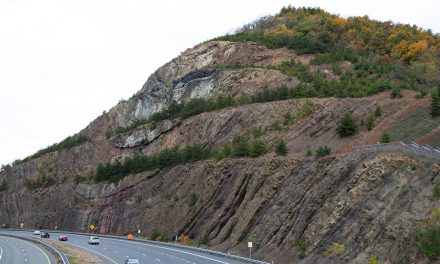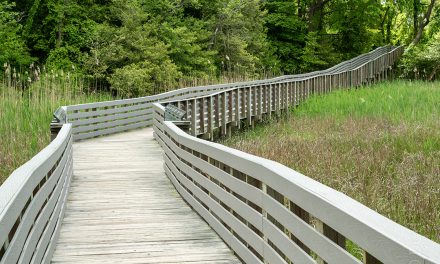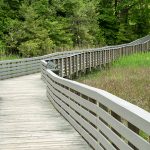
Cabin in Shenandoah

The first morning at Argow Cabin we were up before sunrise.
Dawn slipped out of the warm sleeping bag first, dressing quickly in preparation for the cold dash to the privy. Eyes still closed, I listened to the creak of the stairs as she made her way down to the kitchen, to the muffled sounds of her pulling on her boots, and to the scuffing noise of the front door opening. Just before closing the door behind her, I heard her call up to me.
“Oh my god, the fog!”
I knew immediately what she was talking about. It was the view.

Hiking in the evening before, the first thing we saw as we came out of the forest was the sweet little cabin in the clearing below us, and over the top of it, the panorama of sensuous blue mountains encircling and overshadowing the low wooded hills of Eaton Hollow, a thousand feet below. This, is why we came here.
Argow Cabin is located high on the western slopes of the Blue Ridge Mountains at the edge of what’s now Shenandoah National Park. The main part of the old log cabin was built just before the Civil War by a mountain man and moonshiner named Samuel Eaton. Like most Appalachian homesteads, Eaton’s cabin was constructed of giant chestnut logs that he hewed and shaped by hand. Any other supplies he had to lug up the mountain by mule or, more likely, on his back. In other words, it’s a rustic cabin.
But Eaton and the subsequent owners of Argow Cabin were no fools. It’s fitted out with all the key ingredients of an excellent mountain home: wide plank floors, a big stone fireplace, a massive woodstove in the kitchen, and five tall windows — three downstairs and two upstairs — facing north over Eaton Hollow. As you enter, a wide flight of stairs rises from the middle of the cabin, right between the front door and the central window. To keep the stairs from blocking the view and the light, the cabin’s builder omitted the risers. That means you can stand at the entryway and look straight through the stairs and out the window.
In other words, it’s all about the view.
The night before, rather than sleep on the cabin’s narrow cots, Dawn and I had pushed a couple of the mattresses together on the attic floor and zipped our sleeping bags together on top of them. This arrangement put our heads at the foot of one of those tall upstairs windows.
So, by the time Dawn had pushed the front door shut that first morning, I had already rolled over on my belly and propped myself up on my elbows to take in the view.
It didn’t seem real.

The sun hadn’t yet risen over the ridge behind us, so the valley below was suffused in a hazy twilight. The ranks of long mountain ridges that we had admired the evening before were now painted in soft watercolors. The closer ridges appeared to be brushed in indigo, and the more distant ridges faded into ever paler shades of violet. A river of dense milky fog swirled around the bases of the ridges, flowing gently between the hills in the valley below us. The scene had the eerie beauty of a Bob Ross painting.
This sensuous landscape is the result of a long and tortuous geology. The easternmost part of the Appalachians, the Blue Ridge are among the oldest mountains on Earth, dating back as much as 570 million years, long before there were terrestrial animals to populate them.
The Appalachian, Allegheny and other long-forgotten mountain chains along the East Coast owe their origins to a series of massive collisions between North America and other tectonic plates. The largest of these collisions took place 350 million years ago, when the African plate plowed under North America, uplifting the east coast of the continent to create a mountain chain that was at one time higher than the Himalayas.
The impact of this succession of colliding landmassses wracked and warped and folded those mountains. At the same time, erosion wore them down, gnawing away at the rock for hundreds of millions of years. The detritus from this erosion was so prodigious that it eventually formed the coastal plains that stretch 200 miles east to the Atlantic and the vast wedge of sand and alluvium to the west that we now call Ohio and Indiana.
And this sequence of events — uplift, fold and fault, followed by millenia of erosion and deposition — happened over and over again in the geological history of Appalachia. The Blue Ridge mountains and the ridge and valley structures to their west are simply the nubs of the great mountain chains that preceeded them. Their beauty is the result of millions of years of persistent weathering that has softened their profiles and given them a human scale.
Dawn and I spent most of the morning admiring that scene (and taking photographs) from the cabin’s splendid wrap-around covered porch. Ten feet off the ground on the downhill side, the porch offers unobstructed views of valley and the mountains beyond. As nice as the cabin interior is, in good weather the porch is the center of life at Argow cabin.
In addition to a pair of hefty rockers, it’s provided with a picnic table and a couple of stout built-in tables on either side of the big stone chimney. A dormer in the center of the porch roof lets in a little light. Not so long ago, the dormer vented the smoke from a big firepit that had been built into the floor of the porch. The firepit has since been removed and the porch redecked, but from the downhill side of the cabin, you can still see the remains of the cinderblock ashpit.

But the porch wasn’t part of the original cabin. In fact, as recently as the 1990s, Eaton’s old home was abandoned and falling into ruins. It was only in 2010, after the owner, a local forester named Keith Argow, sold the property to the Potomac Appalachian Trail Club, that things began to look up for the moonshiner’s cabin.
Even then, it took a team of fifteen volunteers five years, working one weekend a month, to shore up the building, refit the interior, and add the porch.
Now, Argow cabin is one of 45 cabins owned by the PATC, which is in charge of maintaining the Appalachian Trail and hundreds of miles of other trails in the Potomac watershed. Most of those cabins are only available to club members, but 18 of them, including Argow cabin, are also for rent to the public.
Dawn and I were members of the PATC until we moved to Hawaii in 2004. We only rejoined the club after returning to the East Coast in 2017. In the 1980s and 1990s, though, we frequently took advantage of the club’s cheap rentals, staying in five or six of the cabins over the years. Our favorite, Jones Mountain cabin in Shenandoah Park, was near to Bear Church Rock and its spectacular views. In addition, the hike in passes through a glorious grove of mountain laurel. But that six-mile hike in is also an arduous one.
By comparison, it’s only about a mile and a half from Eaton Hollow Overlook, where we parked the car, to Argow Cabin. That was partly why we chose it. In fact, that first morning, we had planned to hike back to the car so we could drive up to one of the scenic loop-trails along Skyline Drive. We figured that, after a quick hike, we’d return the car to the Eaton Hollow trailhead and head back down to the cabin. This would also let us retrieve the tripod from the car so we could take a couple of panoramas of the view from the porch.
It didn’t turn out that way.

Due to a miscalculation — I’m not naming names — we understimated the distance of the hike-in to Argow Cabin. Thinking the hike was only about a quarter of a mile, so we had dramatically overpacked, adding an embarassing surplus of snacks and drinks to our packs. And, although the extra weight didn’t make much difference in the beginning, in the end it proved the undoing of our plans.
The hike starts with a lovely contour trail that winds its way along a steep forested hillside. After about a quarter of a mile, though, the trail heads down a ridgeline and widens into a not-so-scenic fire road. At the top of the ridge is Schaire Cabin, which, like Argow Cabin, is owned by the PATC. But for the next mile or so, the fire road grows increasingly steep. We began to worry we were headed the wrong way.
If not for a small PATC sign nailed to a tree, it would be easy to miss the trail to Argow Cabin. It’s a narrow track that heads off into the tall grass to the right of the fire road. It then falls precipitously another half mile through the forest. For some reason, this section of the trail seemed particularly arduous. Stumbling along under the weight of our overloaded packs, that half mile felt like five by the time we reached the cabin. Even as Argow Cabin hove into view, we began to dread the return trip.

It was the memory of this steep section of trail that clouded our plans for a day hike. Of course, we only planned to carry water, a camera, and a pair of binoculars for our little expedition, so the mile-and-a-half stroll back to the car should have been a breeze. But we had only gotten a few yards up the steep slope before we reconsidered our plans and headed back to the rockers on the porch.
Just as well. That gave us more time to enjoy the view. And nap. Most importantly, it allowed us to eat most of the food we had hauled down the mountain. That might be why the hike out the next morning didn’t seem nearly as bad as we expected.
Without all the excess weight, it took less than an hour to reach the overlook.
In fact, after dumping our packs in the back of the Subaru, we didn’t turn the car south and head home as we had planned. Instead, we gulped down a couple of root beers that we had kept in a cooler in the car, then headed north to check out the rest of the views along Skyline Drive.


Dennis is a travel, science, and business writer who has traveled all his life. The son of an Air Force pilot, he was born in England and lived in ten states growing up. Much of his youth was spent in Hawaii and Southeast Asia, where he traveled widely, including extended visits to New Delhi, Singapore, Hong Kong, Vientiane, and old Rangoon.
A Mountain Cabin Build by a Real Mountain Man
82%
Summary Part of the charm of a mountain cabin is that it's a world unto itself. A well-made cabin is self-contained, providing all the key ingredients of a good microexcursion: craftsmanship, beautiful scenery, a sense of history, and a glimpse into another way of life. Sometimes, though, those elements are in tension with one another. Too much craftsmanship, and a cabin can lose its rustic charm. Beautiful scenery often comes at the end of a long hike in. And the life of mountain man can mean leaving the conveniences of the modern world behind. All of those come with pluses and minuses. It's all about balance.










